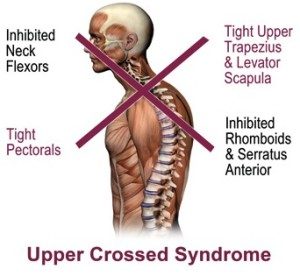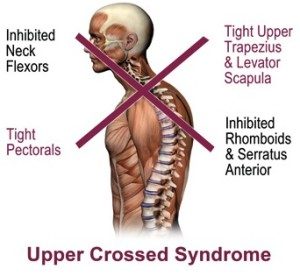
Bruggers Postural Break
In the seated position, begin by placing your feet flat on the floor, and sitting on the edge of the chair. Next, open the shoulders up, and place the hands in the palm up position. Next pull your shoulder blades together and down (making sure that you’re not shrugging your shoulders). Finally, retract the chin. Hold this position for 10 seconds or about 4 deep breaths, with each exhale, try to relax your shoulders and pull them down more.

I usually recommend performing this exercise for about 10 seconds for every 15 minutes that you’re sitting in front of the computer or otherwise working with your arms in front of you. This should help to prevent the onset of Upper Crossed Syndrome and stop neck pain and headaches before they start.
For questions related to this exercise, or any health topic, please call (201) 569-1444 for a free consultation with Drs. Robert Press or Erik Geleta.
In our computerized world, most of us spend entirely too much time in a sitting position, mainly in front of a computer. Even with the most wonderful ergonomics, having your arms out in front of you for multiple hours at a time presents a problem. Dr. Vladimir Janda, a Czech physician described a condition known as “Upper Crossed Syndrome,” in which the pectoralis muscles of the chest, and the sub-occipital muscles just below the back of the skull become over contracted, whereas the deep neck flexor muscles in the front of the neck, and the rhomboid muscles that hold the shoulder blades to the spine become inhibited. This functional muscle imbalance creates the classic “Office Worker Syndrome” or “Student Syndrome” that is so common today, including neck and upper back pain, and frequently tension headaches, or even migraines.
Fortunately, this is an easy problem to prevent, and if you suffer from it, it is very correctable with a few stretches and exercises. Today, we will be looking at a stretch called Bruegger’s Postural Break, which helps to specifically undo the “forward flexed” posture, and strengthen the postural muscles responsible for opposing the forward flexion.
